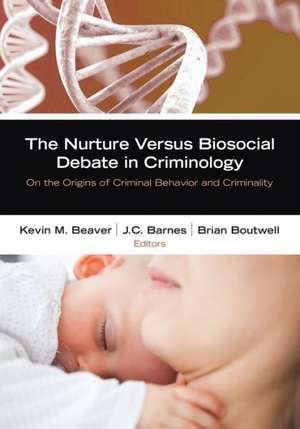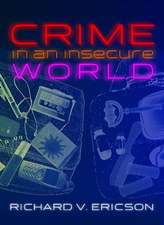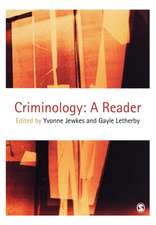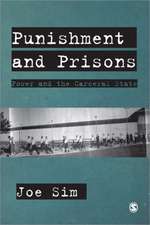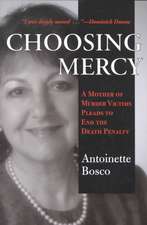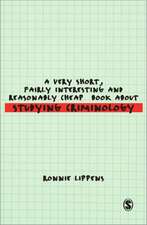The Nurture Versus Biosocial Debate in Criminology: On the Origins of Criminal Behavior and Criminality
Editat de Kevin M. Beaver, J. C. Barnes, Brian B. Boutwellen Limba Engleză Paperback – 26 mar 2014
Preț: 570.14 lei
Preț vechi: 670.75 lei
-15% Nou
Puncte Express: 855
Preț estimativ în valută:
109.10€ • 114.05$ • 92.20£
109.10€ • 114.05$ • 92.20£
Carte tipărită la comandă
Livrare economică 07-21 martie
Preluare comenzi: 021 569.72.76
Specificații
ISBN-13: 9781452242255
ISBN-10: 1452242259
Pagini: 472
Ilustrații: illustrations
Dimensiuni: 178 x 254 x 21 mm
Greutate: 0.82 kg
Ediția:1
Editura: SAGE Publications
Colecția Sage Publications, Inc
Locul publicării:Thousand Oaks, United States
ISBN-10: 1452242259
Pagini: 472
Ilustrații: illustrations
Dimensiuni: 178 x 254 x 21 mm
Greutate: 0.82 kg
Ediția:1
Editura: SAGE Publications
Colecția Sage Publications, Inc
Locul publicării:Thousand Oaks, United States
Recenzii
“The greatest single strength is the uniqueness of topic and approach. Other strengths are the selected topics and structure.”
“This text might lead to an intellectual movement in the community of criminology, stimulate criminologists to revise current criminological theories, and help criminologists formulate new criminological theories.”
“This text might lead to an intellectual movement in the community of criminology, stimulate criminologists to revise current criminological theories, and help criminologists formulate new criminological theories.”
Cuprins
INTRODUCTION: Why We Need a Nature/Nurture Book in Criminology?
PART I: KEY CRIMINOLOGICAL CORRELATES
GENDER
Chapter 1. The Sociological Explanation: Sociological Explanations of the Gender Gap in Offending - Abigail A. Fagan
Chapter 2. The Biosocial Explanation: A Biosocial Explanation for Male-Female Differences in Criminal Involvement - Kevin M. Beaver and Joseph L. Nedelec
RACE
Chapter 3. The Sociological Explanation: Sociological Viewpoint on the Race-Crime Relationship - Nicole Leeper Piquero, Alex R. Piquero, and Eric S. Stewart
Chapter 4. The Biosocial Explanation: Human Bio-diversity and the Egalitarian Fiction - John Paul Wright and Mark Alden Morgan
SOCIAL CLASS
Chapter 5. The Sociological Explanation: A Sociological Analysis of Social Class - Karen F. Parker and Thomas Mowen
Chapter 6. The Biosocial Explanation: The Role of Intelligence and Temperament in Interpreting the SES-Crime Relationship - Anthony Walsh, Charlene Y. Taylor, and Ilhong Yun
PART II: THEORETICAL PERSPECTIVES
LEARNING THEORY
Chapter 7.The Sociological Explanation: Learning Theories of Crime: Promises and Pitfalls - Jonathan R. Brauer and Jonathan D. Bolen
Chapter 8.The Biosocial Explanation: The Integration of Biological and Genetic Factors into Social Learning Theory - Jamie Vaske
SELF-CONTROL THEORY
Chapter 9.The Sociological Explanation: Self-control and Crime: A Sociological Perspective - Callie H. Burt
Chapter 10.The Biosocial Explanation: Low Self-control is a Brain-Based Disorder - Matt DeLisi
STRAIN THEORY
Chapter 11.The Sociological Explanation: The Role of the Social Environment in General Strain Theory - Robert Agnew
Chapter 12.The Biosocial Explanation: General Strain Theory and Biosocial Criminology: Pathways to Successful Theoretical Integration - John M. Stogner
SOCIAL BONDING THEORY
Chapter 13.The Sociological Explanation: Social Bonding and Crime - Ryan Schroeder
Chapter 14.The Biosocial Explanation: A Biosocial View of Social Bond Theory - Danielle Boisvert
PART III: SPECIFIC TYPES OF ANTISOCIAL BEHAVIORS
INTIMATE PARTNER VIOLENCE
Chapter 15.The Sociological Explanation: When Violence is the Norm: Sociological Perspectives on Intimate Partner Violence - Tasha A. Menaker and Cortney A. Franklin
Chapter 16.The Biosocial Explanation: Some Kind of Madness: The Biosocial Origins of Intimate Partner Violence - Brian B. Boutwell and Richard Lewis
CHILDHOOD ANTISOCIAL BEHAVIOR/CONDUCT DISORDER
Chapter 17.The Sociological Explanation: Parents and Peers as Institutions of Socialization in Childhood and Adolescence: Implications for Delinquent Behavior - Carter Rees and Jacob T.N. Young
18. The Biosocial Explanation: A Biosocial Review on Childhood Antisocial Behavior - Chris L. Gibson and Elise T. Costa
DRUG USE AND ABUSE
Chapter 19. The Sociological Explanation: Sociological Criminology and Drug Use: A Review of Leading Theories - J. Mitchell Miller and Holly Ventura Miller
Chapter 20. The Biosocial Explanation: Drug Abuse, Addiction, and Crime: A Cell to Society Perspective - Michael G. Vaughn, Christopher P. Salas-Wright, and Brandy R. Maynard
PART IV: TRENDS, CURRENT ISSUES, AND POLICY IMPLICATIONS
THE CRIME DROP
Chapter 21.The Sociological Explanation: A Sociological Explanation of Crime Rates and Trends - Wesley G. Jennings and Jennifer M. Reingle
Chapter 22.The Biosocial Explanation: Darwin, Dawkins, Wright, Pinker and the Reasons that Crime Declined - Brian B. Boutwell and J.C. Barnes
THE AGE-CRIME CURVE
Chapter 23.The Sociological Explanation: The Age and Crime Relationship: Social Variation, Social Explanations - Jeffery T. Ulmer and Darrell Steffensmeier
Chapter 24.The Biosocial Explanation: The Puzzling Relationship between Age and Criminal Behavior: A Biosocial Critique of the Criminological Status Quo - J.C. Barnes, Cody Jorgensen, Daniel Pacheco, and Michael TenEyck
POLICY IMPLICATIONS
Chapter 25.The Sociological Explanation: Policy Implications of Sociological Theories of Crime: Why are they so Seldom Considered or Discussed? - Danielle J. Baily, Robert Lytle, and Lisa L. Sample
Chapter 26.The Biosocial Explanation: Policy Implications of Biosocial Criminology: Crime Prevention and Offender Rehabilitation - Michael Rocque, Brandon C. Welsh, and Adrian Raine
PART I: KEY CRIMINOLOGICAL CORRELATES
GENDER
Chapter 1. The Sociological Explanation: Sociological Explanations of the Gender Gap in Offending - Abigail A. Fagan
Chapter 2. The Biosocial Explanation: A Biosocial Explanation for Male-Female Differences in Criminal Involvement - Kevin M. Beaver and Joseph L. Nedelec
RACE
Chapter 3. The Sociological Explanation: Sociological Viewpoint on the Race-Crime Relationship - Nicole Leeper Piquero, Alex R. Piquero, and Eric S. Stewart
Chapter 4. The Biosocial Explanation: Human Bio-diversity and the Egalitarian Fiction - John Paul Wright and Mark Alden Morgan
SOCIAL CLASS
Chapter 5. The Sociological Explanation: A Sociological Analysis of Social Class - Karen F. Parker and Thomas Mowen
Chapter 6. The Biosocial Explanation: The Role of Intelligence and Temperament in Interpreting the SES-Crime Relationship - Anthony Walsh, Charlene Y. Taylor, and Ilhong Yun
PART II: THEORETICAL PERSPECTIVES
LEARNING THEORY
Chapter 7.The Sociological Explanation: Learning Theories of Crime: Promises and Pitfalls - Jonathan R. Brauer and Jonathan D. Bolen
Chapter 8.The Biosocial Explanation: The Integration of Biological and Genetic Factors into Social Learning Theory - Jamie Vaske
SELF-CONTROL THEORY
Chapter 9.The Sociological Explanation: Self-control and Crime: A Sociological Perspective - Callie H. Burt
Chapter 10.The Biosocial Explanation: Low Self-control is a Brain-Based Disorder - Matt DeLisi
STRAIN THEORY
Chapter 11.The Sociological Explanation: The Role of the Social Environment in General Strain Theory - Robert Agnew
Chapter 12.The Biosocial Explanation: General Strain Theory and Biosocial Criminology: Pathways to Successful Theoretical Integration - John M. Stogner
SOCIAL BONDING THEORY
Chapter 13.The Sociological Explanation: Social Bonding and Crime - Ryan Schroeder
Chapter 14.The Biosocial Explanation: A Biosocial View of Social Bond Theory - Danielle Boisvert
PART III: SPECIFIC TYPES OF ANTISOCIAL BEHAVIORS
INTIMATE PARTNER VIOLENCE
Chapter 15.The Sociological Explanation: When Violence is the Norm: Sociological Perspectives on Intimate Partner Violence - Tasha A. Menaker and Cortney A. Franklin
Chapter 16.The Biosocial Explanation: Some Kind of Madness: The Biosocial Origins of Intimate Partner Violence - Brian B. Boutwell and Richard Lewis
CHILDHOOD ANTISOCIAL BEHAVIOR/CONDUCT DISORDER
Chapter 17.The Sociological Explanation: Parents and Peers as Institutions of Socialization in Childhood and Adolescence: Implications for Delinquent Behavior - Carter Rees and Jacob T.N. Young
18. The Biosocial Explanation: A Biosocial Review on Childhood Antisocial Behavior - Chris L. Gibson and Elise T. Costa
DRUG USE AND ABUSE
Chapter 19. The Sociological Explanation: Sociological Criminology and Drug Use: A Review of Leading Theories - J. Mitchell Miller and Holly Ventura Miller
Chapter 20. The Biosocial Explanation: Drug Abuse, Addiction, and Crime: A Cell to Society Perspective - Michael G. Vaughn, Christopher P. Salas-Wright, and Brandy R. Maynard
PART IV: TRENDS, CURRENT ISSUES, AND POLICY IMPLICATIONS
THE CRIME DROP
Chapter 21.The Sociological Explanation: A Sociological Explanation of Crime Rates and Trends - Wesley G. Jennings and Jennifer M. Reingle
Chapter 22.The Biosocial Explanation: Darwin, Dawkins, Wright, Pinker and the Reasons that Crime Declined - Brian B. Boutwell and J.C. Barnes
THE AGE-CRIME CURVE
Chapter 23.The Sociological Explanation: The Age and Crime Relationship: Social Variation, Social Explanations - Jeffery T. Ulmer and Darrell Steffensmeier
Chapter 24.The Biosocial Explanation: The Puzzling Relationship between Age and Criminal Behavior: A Biosocial Critique of the Criminological Status Quo - J.C. Barnes, Cody Jorgensen, Daniel Pacheco, and Michael TenEyck
POLICY IMPLICATIONS
Chapter 25.The Sociological Explanation: Policy Implications of Sociological Theories of Crime: Why are they so Seldom Considered or Discussed? - Danielle J. Baily, Robert Lytle, and Lisa L. Sample
Chapter 26.The Biosocial Explanation: Policy Implications of Biosocial Criminology: Crime Prevention and Offender Rehabilitation - Michael Rocque, Brandon C. Welsh, and Adrian Raine
Descriere
Providing a contemporary approach to the nature versus nurture debate, this book encourages reflection on the contest between environmental factors and the interplay between biology/genetics and environmental factors on criminal behaviour.
